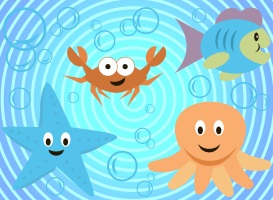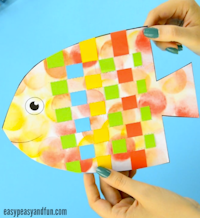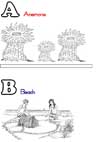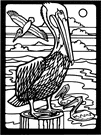Ocean -- Preschool & Kindergarten
Ocean
Ocean Playdough
Use the recipe from the Art Recipes page "The
Best Cooked Play Dough". Scent and color the playdough with
coconut extract and yellow food coloring. While kneading the
playdough you can add gold glitter.
Fingerplays/Songs
Fish Story
One, two three, four, five (hold up fingers while counting)
Once I caught a fish alive,
Six, seven, eight, nine, ten (hold up additional fingers)
Then I let it go again.
Why did I let it go?
Because it bit my finger so.
Which finger did it bite?
The little finger on the right (hold up pinky on the right hand)
Five Oceans
Tune: three blind mice
Five oceans, five oceans,
On the earth, on the earth.
Five oceans cover the earth, you see,
Can you name them all with me?
Pacific, Atlantic, Indian, Arctic, and Southern make five.
Five oceans.
Down in the Deep Blue Sea
Tune: "Shoo-Fly"
Down in the deep blue sea,
Down in the deep blue sea,
Down in the deep blue sea,
What will we see?
We'll see a swimming fish,
We'll see a swimming fish,
We'll see a swimming fish,
That is what we'll see
We'll see a great whale... We'll see an octopus...
5 Little Seashells
5 little seashells lying on the shore,Hold out five fingers.
Swish! went the waves
and then there were four.
Open your other hand and pass it over the five fingers.
4 little seashells pretty as can be,
Swish! went the waves
and then there were three.
3 little seashells all pearly new,
Swish! went the waves
and then there were two.
2 little seashells lying in the sun,
Swish went the waves
and then there was one.
1 little seashell lying all alone,Point one finger
I picked it up
and I took it home!Put it in your pocket
Video
Art
Classroom Windows
Dress up classroom windows like a ship's portholes. Cut out circles from light blue construction paper. Have the children draw sea creatures on the porthole windows. Glue the paper circles in the middle of a paper plate. Children can color the rim of the paper plate. Children will amaze you with their creations of what you see in the ocean through a ship's window.
Ocean Generosity/Friendship Craft
Need: paper plates (recycled, non-bleached if possible!), scissors, stapler, texters, stickers-enough different colours that each child has a unique colour/pattern
First read "The Rainbow Fish" to the class.
Preparation: Cut circle stickers in half to resemble scales (can be done en masse while still on backing)
Set upon each table a set of texters, scissors, and one stapler. With one paper plate at each child’s seat. Demonstrate activity to class.
Cut triangle out of plate and staple it on to the opposite side, as a tail. Draw an eye. Invite the children to do the same.
To each child give a different set of stickers (ie so Tommy has blue, Misha silver,ect). Every child should have a different colour from their classmates. These stickers ideally will be half-circles to resemble fish scales.
The children are free to use all their matching stickers on their fish but they are encouraged to share them with their classmates. In this way all the children will have “rainbow fish” through their generosity. If time allows, invite the children to further decorate their fish with the texters on their tables.
Contributed By: Danica Logan
Story
The Rainbow Fish
by Marcus Pfister
The Rainbow Fish is an international best-seller and a modern classic. Eye-catching foil stamping, glittering on every page, offers instant child appeal, but it is the universal message at the heart of this simple story about a beautiful fish who learns to make friends by sharing his most prized possessions that gives the book its lasting value.
Video
Art
Jellyfish
Need: paper plates, tissue paper or crepe paper cut into 1" x 12" pieces, construction paper or wiggle eyes (optional)
Precut 8 pieces of tissue or crepe paper for each child. Have the children color the back of the paper plate with crayons. Staple the streamers around the edge of the paper plate. Children can create eyes from construction paper or glue on wiggle eyes.
Play slow flowing classical music and have the children and their jellyfish dance with the music.
Seaweed
Fold a sheet of blue construction paper in half. Place a piece of yarn in green paint. Lay the painted yarn on the blue construction paper and fold the paper. Gently place one hand on top of the construction paper while pulling the string out. Repeat again if desired. When dry, your sheets will look like an underwater scene. Can add paper fish, sea creatures, stickers.
Shell Homes
Have the children make their own shell homes--either from a copy of a shell--let the children decorate with sequins, glitter, shells, sand, etc. or from a milk carton. Use small milk cartons. Rinse them out and use them to make shell homes. They can be covered with construction paper and the covered with shell, sand, and other art materials.
Learning Centers
Ocean Corner
Turn a corner of your room into an ocean playground. Hang green crepe paper streamers from the ceiling for algae. Place pillow "rocks" all around. Play a tape of ocean wave sounds. Set out books about the ocean. Hang up pictures of ocean plants and animals on the walls. Let the children read and relax in your ocean corner.
Science
Seashells Sort
Place shells (or laminate paper shells) on a tray on the science table. Place sand or sandpaper on the bottom of the tray. Discuss how the shells are different. Have a child sort the shells and tell how he/she sorted the shells.
Science Table
Place shells and a balancing scale on the science table. The children compare the weights of various shells, predict which ones are the heaviest and lightest, and try to find combinations of shells that, when placed on the scale together, will balance.
Place on the science table a balance scale and clean aquarium rocks. The children can use spoons and measuring cups to transfer the rocks into the scale containers. After this, they can experiment with the balance.
Grow Coral
Grow your own coral. Place several pieces of broken brick or soft coal (charcoal works too) the size of large walnuts in a small aluminum pie pan or saucer.
Then mix together: 4 tablespoons non-iodized salt, 4 tablespoons liquid bluing, 4 tablespoons water, 1 tablespoon household ammonia.
Pour slowly over pieces in dish. Then carefully drop small amounts of food coloring over the rocks. In just a short time, little crystals will begin to form. Don't move it around too much or touch it, because your "coral" will crumble easily.
Ocean In A Bottle
Needed:: plastic water or pop bottles, tape, blue or green food color , baby oil or
vegetable oil, tiny shells, spankles, gold glitter(represents sand)...
Fill the water bottle 2/3 with water and tint it with the food color. Add the oil, filling the jar to within about 1/2 inch of the rim. Add tiny shells, glitter, or other sea related trinkets and seal the jar. Place tape around the top to seal the bottle. Remind the child that Mom would not want the oil on her floors. The child can tip or shake the jar, which looks like rolling ocean waves.
Contributed By: Diane Berson
Dramatic Play Area
Gone Fishing
Set up a fishing area in the dramatic play center. Provide props such as a wooden rocking boat, small wading pool, life vests, tackle boxes, nets, and fishing poles. Fishing poles can be made by attaching string (with a magnet at the bottom) to a short dowel or paper towel tube. Attach paper clips to the construction paper fish (can laminate or cover paper fish with clear contact paper). Then, go fishing!
Seafood Restaurant
Add plastic food and seafood items to a play menu.
Bait and Tackle Shop
Provide props to simulate a bait and tackle shop in the dramatic play area. Items can include a cash register, play money, plastic or paper fish of varying sizes, nets, fishing lures(remove hooks), tackle boxes, coolers, fishing poles, and life vests. Display pictures of fish and people fishing
See Also
Ocean Theme Pages










